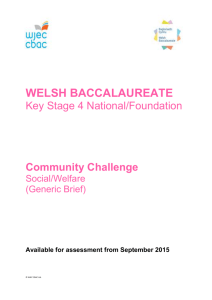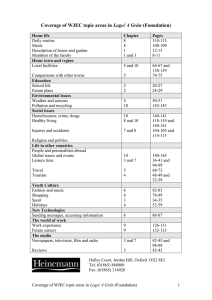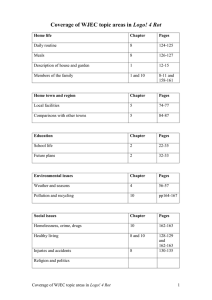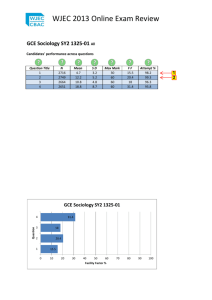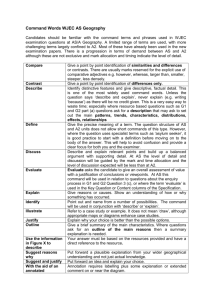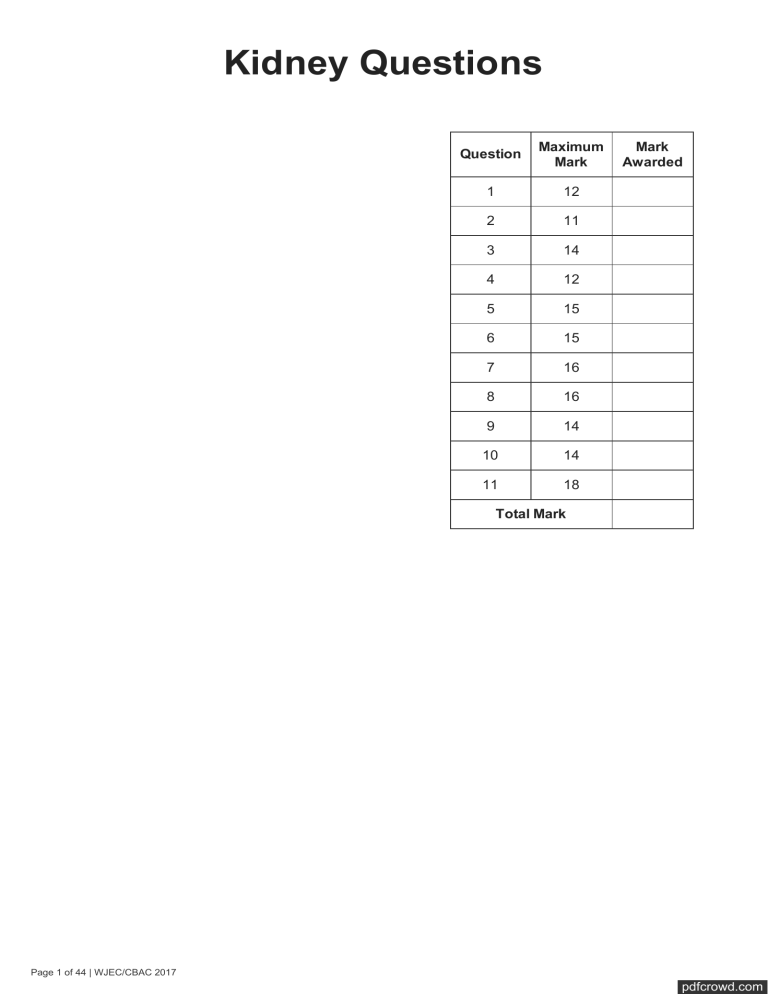
Kidney Questions Question Maximum Mark 1 12 2 11 3 14 4 12 5 15 6 15 7 16 8 16 9 14 10 14 11 18 Mark Awarded Total Mark Page 1 of 44 | WJEC/CBAC 2017 pdfcrowd.com 1. Page 2 of 44 | WJEC/CBAC 2017 pdfcrowd.com Page 3 of 44 | WJEC/CBAC 2017 pdfcrowd.com 2. Roughly 60% of the mass of the body is water and despite wide variation in the quantity of water taken in each day, body water content remains incredibly stable. One hormone responsible for this homeostatic control is antidiuretic hormone (ADH). (a) Describe the mechanisms that are triggered in the mammalian body when water intake is reduced. [6] (b) The graph below shows how the plasma concentration of antidiuretic hormone changes as plasma solute concentration rises. (i) Describe the relationship shown in the graph opposite. Page 4 of 44 | WJEC/CBAC 2017 pdfcrowd.com [2] (ii) Suggest why a person only begins to feel thirsty at a plasma solute concentration of 293 AU. [2] Secretion of antidiuretic hormone is stimulated by decreases in blood pressure and volume. These are conditions sensed by stretch receptors in the heart and large arteries. Severe diarrhoea is one condition which stimulates ADH secretion. (c) Suggest another condition which might stimulate ADH secretion. [1] Page 5 of 44 | WJEC/CBAC 2017 pdfcrowd.com 3. The diagram below shows a single nephron, with its blood supply, from a kidney. (a) (i) Name A, B and C shown on the diagram above. [3] A. . . . . . . . . . . . . . . . . . . . . . . . . . . . . . . . . . . . . . . . . . . . . . . . . . . . . . . . . . . . . . . . . . . . . . . . . . . . . . . . . . . . . . . . . . . . . B............................................................................................. C............................................................................................. (ii) Use two arrows, clearly labelled, on the nephron above, to show where the following processes take place: [2] I ultrafiltration; Page 6 of 44 | WJEC/CBAC 2017 pdfcrowd.com II selective reabsorption. (b) Name the blood vessels supplying the kidney which would connect at points X and Y shown on the diagram opposite. [1] X............................................................................................. . Y............................................................................................. . (c) Explain the function of the Loop of Henle in osmoregulation. [4] (d) Describe how hormonal control affects the final concentration and volume of urine produced when someone is dehydrated. [4] Page 7 of 44 | WJEC/CBAC 2017 pdfcrowd.com 4. Page 8 of 44 | WJEC/CBAC 2017 pdfcrowd.com Page 9 of 44 | WJEC/CBAC 2017 pdfcrowd.com 5. Page 10 of 44 | WJEC/CBAC 2017 pdfcrowd.com Page 11 of 44 | WJEC/CBAC 2017 pdfcrowd.com 6. Page 12 of 44 | WJEC/CBAC 2017 pdfcrowd.com Page 13 of 44 | WJEC/CBAC 2017 pdfcrowd.com 7. Page 14 of 44 | WJEC/CBAC 2017 pdfcrowd.com Page 15 of 44 | WJEC/CBAC 2017 pdfcrowd.com 8. A student gave a sample of urine and then drank 1000 cm³ of distilled water rapidly. Urine was then collected at regular intervals and measurements made of the volume of each sample and its salt concentration. The results are shown on the following graphs. (a) (i) Using your knowledge of osmoregulation, explain the change in the volume of urine between 0 - 60 minutes. [4] (ii) Explain the change of concentration of salt in the urine between 0 and 60 minutes. [1] (iii) State two variables which would need to be considered when comparing results from a number of people who had drunk similar volumes of water. Page 16 of 44 | WJEC/CBAC 2017 pdfcrowd.com [2] (b) The diagram below represents part of a kidney nephron showing a glomerulus and Bowman's capsule. (i) Explain how the high hydrostatic pressure (10 kPa) is achieved in the glomerulus [1] (ii) Suggest which type of organic molecule in the blood is responsible for maintaining the blood osmotic pressure at 4 kPa. [1] (iii) The net movement of water is from A to B. Explain the process by which some water molecules will move from B to A. [2] Page 17 of 44 | WJEC/CBAC 2017 pdfcrowd.com (iv) The net filtration pressure is the overall pressure responsible for ultrafiltration. From the data shown on the diagram calculate this value. Show your working include units with your answer. [2] Answer . . . . . . . . . . . . . . . . . . . . . . . . . . . . . . . . . . . . . . . (c) There is a feedback system in the kidneys which maintains the hydrostatic pressure in the glomerulus at a constant level despite changes in the arterial blood pressure. The regulatory mechanism involves the contraction of the circular muscles in the afferent arteriole. (i) Explain how this prevents changes in the hydrostatic pressure in the glomerulus. [2] (ii) Suggest what would happen in the body if the arterial blood pressure increased and the feedback system in the kidney described did not function. [1] Page 18 of 44 | WJEC/CBAC 2017 pdfcrowd.com 9. (a) Kidneys can become damaged by injury or disease. (i) Give four possible effects of kidney failure. [4] (ii) Suggest why heart disease or the loss of a large volume of blood can lead to kidney failure. [2] Patients with kidney failure can be treated using dialysis. During dialysis blood can be taken from an artery, large vein or a fistula which is created by surgically connecting an artery directly to a vein. The picture below shows the appearance of such a fistula. Page 19 of 44 | WJEC/CBAC 2017 pdfcrowd.com (b) Explain the appearance of the vein shown in the photograph above which forms the fistula. [2] (c) The blood from the patient is passed through a haemodialysis tube. The tube is made from thousands of very small hollow fibres each made from a partially permeable membrane with pores of various sizes. The partially permeable membrane blocks the passage of cells, platelets and large proteins but will allow solute molecules through. The dialysisfluid lacks substances such as urea, contains the same concentration of ions such as potassium and calcium and has the same water potential as blood from a person who has functional kidneys. The following show a picture of a haemodialysis tube and a diagram representing how it is used. Page 20 of 44 | WJEC/CBAC 2017 pdfcrowd.com (i) State why the dialysis fluid has to be constantly replaced. [1] (ii) Explain why the dialysis fluid moves in the opposite direction to the flow of blood. [1] (iii) Explain why during some dialysis treatments calcium ions diffuse from the patient's blood into the dialysis fluid but during others they diffuse from the dialysis fluid into the patient's blood. Page 21 of 44 | WJEC/CBAC 2017 pdfcrowd.com [1] (d) Transplanted kidneys are more efficient than dialysis but there are some issues concerning the technique. Suggest two reasons against the use of kidney transplants. [2] (e) The kidney also acts as an endocrine organ. What is meant by the term endocrine organ? [1] Page 22 of 44 | WJEC/CBAC 2017 pdfcrowd.com 10. (a) Name the vessel that brings blood to the kidney. [1] (b) Describe two structural features of glomeruli that allow ultrafiltration to occur. [2] 1. ............................................................................................................................................................................................ 2. ............................................................................................................................................................................................. Ultrafiltration in the glomerulus results in the production of glomerular filtrate. The pie charts below show the percentage composition of solutes in human glomerular filtrate and in urine. (c) Using your knowledge of processes occurring in the nephron, explain the difference in glucose concentration between glomerular filtrate and urine shown in the pie charts. [2] (d) (i) The urea concentration of urine is much higher than that of glomerular filtrate. Describe the role of the nephron and collecting duct in achieving this increase in concentration. [5] Page 23 of 44 | WJEC/CBAC 2017 pdfcrowd.com (ii) Suggest an advantage to mammals of excreting urine with a high concentration of urea. [2] (e) The concentration of sodium ions in the urine of a person varies. The concentration is affected by the level of a hormone. Name this hormone and explain how it affects the concentration of ions in urine. [2] Page 24 of 44 | WJEC/CBAC 2017 pdfcrowd.com 11. The diagram below shows a kidney nephron and part of its blood supply. (a) (i) Name the structures labelled A-F in the diagram opposite. [3] A= . . . . . . . . . . . . . . . . . . . . . . . . . . . . . . . . . . . . . . . . . . . . . . . . . . . . . . . . . . . . . . . . . . . . . . . . . . . . . . . . . B=................................................................................. C=................................................................................. Page 25 of 44 | WJEC/CBAC 2017 pdfcrowd.com D=................................................................................. E=................................................................................. F=................................................................................. (ii) Draw a line labelled X on the diagram opposite, to show the part of the nephron where most of the water is reabsorbed. [1] (iii) Draw a line labelled Y on the diagram opposite, to show the part of the nephron where glucose is reabsorbed. [1] (iv) Explain the significance of the differences in diameter between structure B and structure D. [2] (b) The composition of filtrate for a particular substance in a nephron can be expressed as its renal : plasma ratio. This compares the concentration of a substance in the filtrate with that in the blood plasma. This can be calculated by using the following formula. Samples of filtrate were taken from different parts of a nephron and the concentrations of glucose and urea were measured. Their renal : plasma ratios were then calculated. The kidney was treated with a chemical Z and the process was repeated. The results of this investigation are shown in the graph below. Page 26 of 44 | WJEC/CBAC 2017 pdfcrowd.com (i) Explain why urea and glucose have a renal : plasma ratio of 1.0 in the Bowman's capsule. [3] (ii) Use figures from the graph opposite to explain why the renal : plasma ratio of urea increases in the proximal convoluted tubule. [4] (iii) Use figures from the graph opposite to describe and explain the renal : plasma ratio for glucose in both the untreated healthy kidney and the kidney treated with chemical Z. [3] Page 27 of 44 | WJEC/CBAC 2017 pdfcrowd.com (iv) Suggest how chemical Z could have caused the effect described in part (iii) above. [1] Page 28 of 44 | WJEC/CBAC 2017 pdfcrowd.com Marking Scheme 1. Page 29 of 44 | WJEC/CBAC 2017 pdfcrowd.com 2. Page 30 of 44 | WJEC/CBAC 2017 pdfcrowd.com 3. Page 31 of 44 | WJEC/CBAC 2017 pdfcrowd.com 4. Page 32 of 44 | WJEC/CBAC 2017 pdfcrowd.com 5. Page 33 of 44 | WJEC/CBAC 2017 pdfcrowd.com 6. Page 34 of 44 | WJEC/CBAC 2017 pdfcrowd.com 7. Page 35 of 44 | WJEC/CBAC 2017 pdfcrowd.com Page 36 of 44 | WJEC/CBAC 2017 pdfcrowd.com 8. Page 37 of 44 | WJEC/CBAC 2017 pdfcrowd.com 9. Page 38 of 44 | WJEC/CBAC 2017 pdfcrowd.com 10. Page 39 of 44 | WJEC/CBAC 2017 pdfcrowd.com 11. Page 40 of 44 | WJEC/CBAC 2017 pdfcrowd.com Examiner's Comments 1. Well answered apart from (c). It was apparent that candidates from some centres had not studied this addition to the new specification. This comment originally referred to question 3 on paper 1074/01 (24/01/2011) 2. Part (a) routinely gained all six marks, again being recall work that had been well rehearsed. Some confusion over the correct term osmoreceptors with the word 'osmoregulators' was evident and also describing how a low water content meant the blood would have a high solute potential. Presumably this was meant to be high solute concentration. Part (b) was a problem for some, since the ability to describe the graph was of varying standard. At A2, candidates should be able to describe graphs including some reference to the data/axes on the graph to illustrate their description. This was a two mark question which required them to realise there was a point at 282au solute concentration where there was a change in the level of ADH. Part(ii) routinely gained one mark, but only the best scripts gained the second mark point. Many misunderstood the graph and said that the 'delay' was because it took time for the ADH to reach the kidneys. Having clued candidates into the idea of blood pressure and volume in c) it should have been a simple extension to come up with 'blood loss', but this was, in fact, not at all common; the knee-jerk response 'diabetes' was probably as frequent. (Untreated diabetes was credited.) This comment originally referred to question 4 on paper 1074/01 (10/01/2014) 3. A straight recall question and providing candidates had read the question and had learned the work, they gained full marks. Errors were in (a)(ii) not knowing where the two processes occurred, in (b) giving blood vessels supplying the glomerulus not the kidney and in (d) giving a general description of how ADH operates in homeostasis rather than focussing on dehydration. This comment originally referred to question 4 on paper 1074/01 (13/06/2014) 4. (a) (i) Usually correct responses given, the most common incorrect being nephron. (ii) Proximal convoluted tubule, Bowman's capsule and glomerulus identified by almost all candidates. (iii) The common error was not qualifying a statement for example 'mitochondria' rather than 'large numbers of bacteria'. Marks were also lost by stating features which were not visible for example, transfer proteins/ protein pumps / receptors. (b) Most candidates were not able to describe how ultrafiltration takes place with any precision or detail. Some candidates adopted a 'pick and mix' approach and wrote all they knew about the kidney and others confused ultrafiltration with selective reabsorption or the function of the kidney in the control of water potential in the blood. There was much confusion! This comment originally referred to question 5 on paper 1074/02 (11/01/2013) Page 41 of 44 | WJEC/CBAC 2017 pdfcrowd.com 5. The majority of candidates were able to name a nephron in part (a). In part (b) (i) almost all candidates correctly identified the parts A-F though there was some confusion about proximal and distal convoluted tubules. Relatively fewer candidates were able to correctly describe the function of the loop in (b) (ii). In part (c) most candidates were able to name the hormone in part (i) and the endocrine gland in part (ii), but in part (iii) fewer recognised the wall of the collecting duct as the effector, nor how the hormone changes the permeability in part (iv). Most candidates were able name the nitrogenous excretory product in freshwater fish, fewer knew that for insects, and even fewer were able to explain the advantage to insects of excreting uric acid. This comment originally referred to question 6 on paper 1074/01 (13/06/2011) 6. (a) The majority of candidates were able to name a nephron. (b) (i) Almost all candidates correctly identified the parts A-F though there was some confusion about proximal and distal convoluted tubules. (ii) Relatively fewer candidates were able to correctly describe the function of the loop. (c) Most candidates were able to name the hormone in part (i) and the endocrine gland in part (ii), but in part (iii) fewer recognised the wall of the collecting duct as the effector, nor how the hormone changes the permeability in part (iv). Most candidates were able to name at least two treatments for kidney damage and give simple descriptions, there was some confusion about peritoneal dialysis. This comment originally referred to question 6 on paper 1074/02 (13/06/2011) 7. Part (a) was well answered by the majority of candidates but many were unaware of the adaptations of the cells of the proximal convoluted tubule. Part (c) was particularly poorly answered. Phrases such as 'cleaning the blood' and 'the dialysate contains the right amount of chemicals' should be avoided at this level. Use of the expected terms 'water potential' and concentration gradient' were rare. This comment originally referred to question 3 on paper 1074/02 (24/01/2011) 8. Many candidates incorrectly assumed that an increase in water potential in the blood would result in more ADH being released by the pituitary but an explanation of the change in concentration of salt in the urine and stating two variables which would need to be considered caused no difficulty. Candidates appreciated how a high hydrostatic pressure is achieved in the glomerulus but many could not give the type of organic molecule in the blood responsible for maintaining the blood osmotic pressure at 4kPa. Common incorrect responses were red blood cells, cells, ADH, glucose and salt. Some candidates did find difficulty with the calculation. Surprisingly few candidates seemed to appreciate that if the circular muscles in an arteriole contract the lumen would get smaller and in consequence there would be less difference between the afferent and efferent diameter and therefore the pressure would drop. Page 42 of 44 | WJEC/CBAC 2017 pdfcrowd.com This comment originally referred to question 6 on paper 1074/02 (13/06/2014) 9. (a) (i) Well answered but many candidates put an emphasis on the kidneys not being able to reabsorb materials from the proximal convoluted tubule rather than the consequence of a failure in the process of ultrafiltration. (ii) Many candidates were able to state that heart disease or the loss of a large volume of blood would lead to a fall in blood pressure and that this would affect ultrafiltration by the kidney but many candidates thought that the kidney cells would die or not work properly if there was a reduced blood supply to the kidneys. (b) Very few candidates were able to state that connecting an artery to a vein would cause the vein to expand as a result of the high blood pressure. An appreciation of the difference in structure and function of arteries and veins as taught in unit 2.4 was rarely shown. Candidates should be reminded that there are a small % of synoptic marks in HB4. (c) (i) in(ii) Candidates did appreciate that the dialysis fluid has to be replaced to maintain a concentration gradient but very few stated that the dialysis fluid moving in an opposite direction to the flow of blood would maintain a concentration gradient along the length of the haemodialysis tube. Most candidates appreciated that calcium ions could diffuse in either direction depending on the concentration gradient. (d) Most candidates appreciated the possibility of rejection and the surgical risks. Marks were lost by mentioning immunosuppressants without stating why the use would be a disadvantage and by making statements such as 'expecting someone to donate a kidney is just not fair or bad news!' Ethical arguments were not clearly stated. (e) Very few candidates knew what an endocrine organ was but much imagination was shown in the responses! This comment originally referred to question 1 on paper 1074/02 (10/01/2014) 10. The renal artery was identified by the majority of candidates in part (a), but there were a number of incorrect answers given. These included; renal vein, aorta, afferent artery, efferent artery, artery unnamed. Part (b) was not well answered. There were a number of vague answers and some confusion about podocytes. Some candidates described the build-up of hydrostatic pressure because of the wider diameter of the afferent arteriole compared to the narrower diameter of the efferent arteriole, but many made a vague reference to size, e.g. the afferent arteriole is 'bigger' or 'thicker'. Most candidates knew that glucose is reabsorbed for part (c) but they did not all refer to the proximal convoluted tubule or active transport for the second mark. In part (d)(i) , many candidates gave a reasonable account of the function of the loop of Henle but relatively few gave a full account explaining essentially that water is reabsorbed but urea is not. Some gave an account of regulation by Page 43 of 44 | WJEC/CBAC 2017 pdfcrowd.com ADH more appropriate for part (e).There was some misinterpretation of the question in part (d)(ii) , some suggesting it was because urea is toxic. Almost all candidates identified ADH as the hormone in part (e), but they did not all give a complete explanation of how the concentration of ions in urine is affected. This comment originally referred to question 7 on paper 1074/01 (11/06/2013) 11. The simple identification of parts of a kidney tubule proved to be too challenging for many candidates. The commonest mistakes were confusion between the afferent and efferent arterioles and a failure to correctly name the loop of Henle. Very few candidates scored both marks for parts(ii) and(iii) . Part (iv) was well answered though a significant number of candidates failed to specify an increase or high blood pressure instead, simply mentioned pressure. Some mentioned hydrostatic pressure. Part (b)(i) caused difficulties. Whilst many candidates recognised that the concentration of glucose and urea were the same in both the plasma and the filtrate, few described how that situation had come about. Many candidates in answering part (b))(ii) missed the point about the re-absorption of water. Instead, many chose to discuss the re- absorption of glucose which would not have affected the concentration of urea. A significant number did manage to score a mark with a reference to the non-re-absorption of urea. Part(iii) was well answered with many candidates making use of figures quoted from the graphs to illustrate their answer, which was most encouraging. Credible suggestions for the way in which inhibitor Z works were few and far between. The commonest correct answers made reference to blocking the pores in the membrane or inhibiting active transport. This comment originally referred to question 6 on paper 1074/02 (11/06/2013) Page 44 of 44 | WJEC/CBAC 2017 pdfcrowd.com



